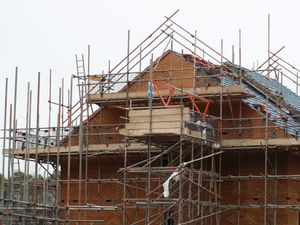Housebuilding to hit 40-year high as red tape cut, but buyers ‘need support’
The Office for Budget Responsibility has forecast that Labour’s planning reforms will boost housebuilding by 170,000 over the next five years.

Planning reforms will see housebuilding reach a more than 40-year high by 2030, but calls ramped up for more action to boost the flagging property market and help get buyers on to the property ladder.
The UK’s fiscal watchdog, the Office for Budget Responsibility (OBR), has forecast that Labour’s reforms to cut planning red tape will boost housebuilding by 170,000 over the next five years, to 305,000.
This will put the Government on track to add around 1.3 million to Britain’s stock of homes in the UK, a rise of 16%, by the end of Parliament.
The moves will also boost growth by £6.8 billion, adding 0.2% to economic output by 2030, according to the forecasts.
But the OBR said despite seeing a marked increase in new houses, planning reforms will only increase the overall housing stock by 0.5% by the end of the decade and will not alone be enough to see the Government meet its 1.5 million homes target.
And while the measures will add 1.3 million to the housing stock, this is for the UK as a whole, whereas the Government’s 1.5 million target under its Plan for Change is for England alone.
The Treasury said: “Further reforms, such as the Planning and Infrastructure Bill, the Government’s long term housing strategy and the new affordable homes programme, on which the government made a £2 billion down-payment this week, are not reflected in the forecast and will all help to reach the 1.5 million target.”
The OBR added house prices will fall as a result of the measures, with less of a strain on housing supply as new properties are built, reducing values by around 0.8% in 2029.
Experts said while welcome, the planning reforms do not address the difficulties faced by first time buyers unable to make the first step on to the ladder.
Felicity Barnett, lender operations manager at the Mortgage Advice Bureau, said: “More emphasis needs to be placed on the first time buyer market.
“As an industry, we must now work as a collective to lower the current average first time buyer age of 35 plus, providing those in their 20s with more accessible, affordable options to get on the property ladder.
“In particular, there needs to be a marked shift in boosting the number of renters transitioning to become first-time buyers.
“These are prospective homeowners who are currently trapped by strict affordability criteria.”
She said the industry is awaiting details from the Financial Conduct Authority (FCA) in the coming months on how mortgage lending rules will be relaxed.
There was also little offered to help bolster the current property market, with home buyers still facing a stamp duty cliff edge in the coming days, which will see “nil rate” bands shrinking.
Some people have sought to bring forward home purchases to beat the increase in the tax, which applies in England and Northern Ireland.
The FCA recently said it is looking at its expectations for mortgage lending as part of proposals to streamline its rules, which could make it easier for some people to buy a home.
Richard Donnell, executive director at Zoopla said: “The housing market needs a strong and growing economy to support housing supply.
“It’s promising to see the Government focusing on longer-term impact by boosting funding for new homes and avoiding short-term measures like stamp duty holidays that don’t really help with the fundamental challenges in the housing market.
“The top priority should be an easing of mortgage regulations, which will support first-time buyers, an important buyer group for homebuilders and the broader market.
“This would also help the rental sector, where there are still 12 people chasing every home for rent, with those on low incomes bearing the brunt.”
The Treasury said the Government was “bringing forward a £625 million package of skills measures to address large-scale skills shortages in the construction sector” and help it meet its new homes pledge.
Efforts to train and help supply workers for the housebuilding aims will cost the Government £95 million in 2025-26, rising to £225 million a year in 2027-28 and 2027-29, according to the Treasury’s spring statement documents.





